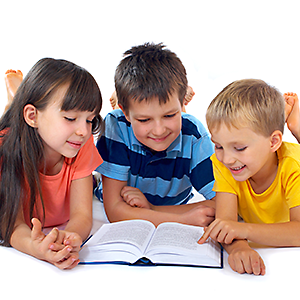Theodor Geisel chose the pen name “Dr. Seuss” because his father wanted him
to be a doctor. (Seuss is his mother’s birth name.) How lucky for us that
he pursued a career in art and children’s literature, forever changing the
way that early-reader books were written.
Before Dr. Seuss, early-reader books for children were didactic, spare and,
frankly, boring. Dick and Jane aren’t nearly as fun as Thing 1 and Thing 2.
Geisel wrote his 16th book, “The Cat in the Hat,” to make
learning to read more fun for children, using 236 of the words from a list
his publisher said a first-grader could read. He later wrote “Green Eggs
and Ham” to win a bet with his editor, Bennett Cerf, that he couldn’t write
a book with only 50 different words.
Geisel also invented words to incorporate a rhyming rhythm (“wocket” with
“pocket” and “nooth grush” with “tooth brush” for example). The silliness
of the words underlies an essential seriousness about children’s
literature: They are better for teaching vocabulary than any conversation
or flash cards ever could be.
In day-to-day conversation, we might say to a friend, “let’s eat a snack by
that clump of trees over there.” In a book, a writer could easily say,
“they picnicked under a copse of trees, relishing the shade of the verdant
elms.” When you read with your child, they’ll get the vocabulary from the
context, but also from your explanations. Don’t be afraid to define a word
or, if you don’t know it, to let them know how you can look it up together.
Even made-up terms can teach how words are constructed and how they convey
meaning. (Kids can usually differentiate between real words and made-up
words.) In some cases, the made-up words resonate so much that they
eventually enter our vocabulary. The first instance of the word “nerd” in
print is the Dr. Seuss book, “If I Ran the Zoo.” In 2017, the 20 th anniversary of Read Across America, the word “Seussian” –
defined as “having a playfully inventive or outlandish quality typical or
reminiscent of the words and images found [in Dr. Seuss books]” – entered
the Merriam-Webster dictionary.” One can imagine that Geisel might reply,
“From there to here, from here to there, funny things are everywhere” (from
“One Fish Two Fish Red Fish Blue Fish”).
Every children’s book communicates three stories: the story told by the
words, the story told by the pictures and the story told by putting them
together. In addition to a varied vocabulary, the illustrations can bring
an author’s imaginings to life and showcase a different world than a
child’s everyday experience. Fanciful characters distinguish Seuss books
from others – you can tell in a moment if an illustration came from a Dr.
Seuss book. These imaginative characters are the result of a very relatable
problem: Geisel admitted to the Saturday Evening Post in 1957, “I
just never learned to draw.”
Even as your children become independent readers, find time to read with
them. Reading with your child can help them process deeper concepts because
you can pause to gauge reactions and discuss. For example, J.K. Rowling’s
“Harry Potter” books begin to get thematically darker from the fourth book
on. By reading the series with your child (especially if you’ve never read
them yourself), you can help your child process Harry’s experiences,
emotions and reactions.
Some additional tips:
-
If your child doesn’t like to sit still (it can’t just be my
kids!), offer some activity for them to do while you read them a
chapter book. Coloring, Silly Putty and LEGOs are wonderful
activities for helping children focus while they listen. -
Sitting with children, creating snuggly moments, helps them
associate reading with pleasurable activities, not with chores. -
Discussing the books – talking about a story is how children
process and remember it – adds to the learning. Defining words that
might be new helps children learn vocabulary. -
Let kids learn to read with books that speak to their interests:
There are reading primers that feature superheroes to princesses
and everything in between. -
Want to know more about the science of teaching your child to read?
There’s a great book written for parents and educators: “Book
Smart: How to Develop and Support Successful, Motivated Readers” by
Anne E. Cunningham and Jamie Zibulsky. -
To fill your home bookshelves, there are a few options for free
books for families in our area: PJ Library and PJ Our Way
(shalomdc.org/pjlibrary) offer books for Jewish and interfaith
families with kids six months to 12 years old, and Books from Birth
(dclibrary.org/freebooks) offers books for families living in D.C.
with kids under five years old.
Here are a few books to read in honor of the National Education
Association’s Read Across America Day, celebrated on March 2, Geisel’s
birthday:
-
“A Poem for Peter” by Andrea Davis Pinkney, illustrated by Lou
Fancher and Steve Johnson -
“I Can Read with My Eyes Shut!” by Dr. Seuss
-
“Library Mouse” by Daniel Kirk
-
“Lola at the Library” by Anna McQuinn and Rosalind Beardshaw
-
“Reading Makes You Feel Good” by Todd Parr
-
“We Are in a Book!” by Mo Willems
”
It is not enough to simply teach children to read; we have to give them
something worth reading. Something that will stretch their imaginations
– something that will help them make sense of their own lives and
encourage them to reach out toward people whose lives are quite
different from their own.”
— Katherine Paterson, author of “Bridge to Terabithia,” “The Great Gilly
Hopkins” and 30 other books.

